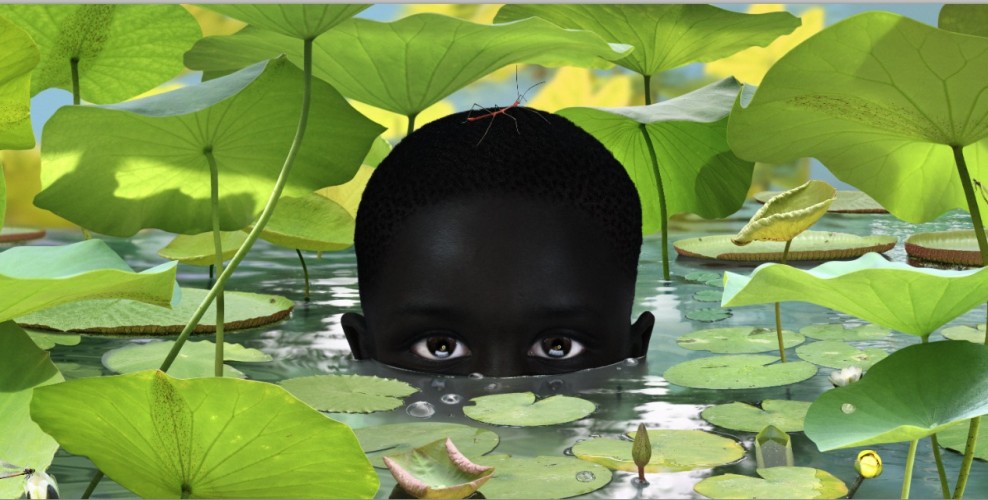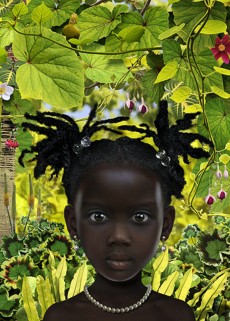
Award-winning fine art photographer Ruud van Empel effortlessly reposes above the photoshop fray with his highly personalized digital process and his unique take on popular themes.
In his works, child-subjects peer candidly through unnatural, supersaturated primordial verdure, appearing surreal in the implied contradiction. In fact, these children and their surroundings are hybrids – jarringly improbable perfection resulting from the painstaking synthesis of thousands of photographic parts into a brave new whole.
The result is an innovation – at once inviting and unsettling – on the themes of innocence and nature and on the human role within the latter, as effect and as agent.
 That many of van Empel’s mortal amalgamations – intended symbols of both themes – are also African has not gone unnoticed. It marks them as political by default. However, beauty is the keynote that defines all else within the images – works that in fact were never intended to politically engage. And, this suggests a victory for a certain state of nature and of innocence by speaking volumes on beauty’s subjectivity.
That many of van Empel’s mortal amalgamations – intended symbols of both themes – are also African has not gone unnoticed. It marks them as political by default. However, beauty is the keynote that defines all else within the images – works that in fact were never intended to politically engage. And, this suggests a victory for a certain state of nature and of innocence by speaking volumes on beauty’s subjectivity.
 Kid-in sat down with Ruud van Empel to discuss his take on these subjects as well as the synergistic, if often surprising, relationship in art between intention and effect.
Kid-in sat down with Ruud van Empel to discuss his take on these subjects as well as the synergistic, if often surprising, relationship in art between intention and effect.
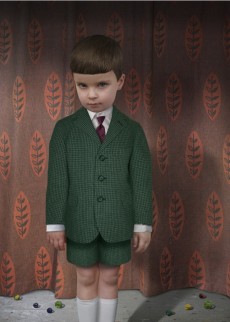 Describe your childhood; did you come from an artistic family?
Describe your childhood; did you come from an artistic family?
No, not really, my father was an electrician and my mother did needlework. We lived in a small flat in Breda and I had a very standard upbringing, no different from any body else my age growing up in the Netherlands.
Were you an especially artistic child and did you prefer any medium above another?
Yes, I was very artistic, doing a lot of drawing, and that got some attention. Soon I was being asked often to make a large-scale drawing on the chalkboard for teachers’ birthdays. But I had no special or preferred medium as a child. I tried everything.
What from your childhood culture had the biggest impact on you?
The animated films of Walt Disney made the biggest impression on me. They set me dreaming to also do this. I loved the world of cartoons.
 Does Disney have an impact on your work today in any traceable way?
Does Disney have an impact on your work today in any traceable way?
Not that I am aware of, but I did like the way the forest was depicted in Bambi. Very impressive.
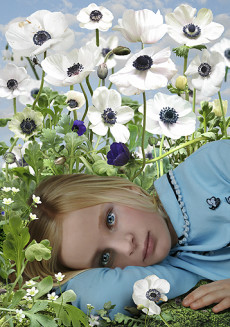 Any epiphanies that led you to chose art as a career? Any person who influenced this decision?
Any epiphanies that led you to chose art as a career? Any person who influenced this decision?
There was really no moment of epiphany. Everybody told me in fact not to follow a career in art. They all said there was no money in it. They advised me to become an art teacher, but in the end they concluded I was no good for anything but making art, and I was eventually allowed to go to an art University.
You came to photography after a background in graphic design and set design. How might these inform your work in photography today?
There is no influence really, from the work that I did before I started to do my art. I studied graphic design because I used to make comic books, but I really should have studied painting/contemporary art. After graduating, I worked shortly as a graphic designer, but I didn’t like it, so I started to make sets for the theatre. That gave me more freedom. From there, a whole career unfolded doing sets for TV and film. But in the mid 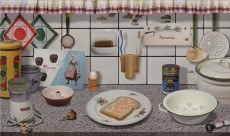 ‘nineties I radically changed over to do what I wanted to do the most – and that was being an artist. I needed that full freedom and it was important to follow my heart.
‘nineties I radically changed over to do what I wanted to do the most – and that was being an artist. I needed that full freedom and it was important to follow my heart.
What mediums do inspire or influence your photography?
I suppose painting and sometimes sculpture. Movies can give me ideas sometimes.
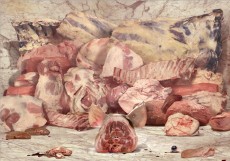 Which films are inspiring to you?
Which films are inspiring to you?
I refer to the framing of a shot, the photography of the film. There are so many. Amongst them: La Dernier Annee de Marienbad, Black Narcissus and Playtime.
Your works are both beautiful and unsettling. I’ve read that you considered beauty an important element with which to begin your series. Can you elaborate?
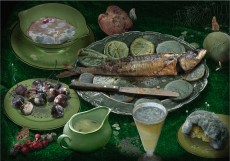 Beauty is one of the things that after all those years can still impress me. Other things have lost that ability. I like beauty. But my art expresses its own kind of beauty. I imagine there are some who think my art is not beautiful at all. I can understand that. My work asks questions about beauty; some things in it are not really beautiful but scary or even ugly to some, so taste is an issue, and everybody has different taste, there is no such thing as good taste in art. Nonetheless, I believe that I need to express my own kind of beauty, say the things I want to say.
Beauty is one of the things that after all those years can still impress me. Other things have lost that ability. I like beauty. But my art expresses its own kind of beauty. I imagine there are some who think my art is not beautiful at all. I can understand that. My work asks questions about beauty; some things in it are not really beautiful but scary or even ugly to some, so taste is an issue, and everybody has different taste, there is no such thing as good taste in art. Nonetheless, I believe that I need to express my own kind of beauty, say the things I want to say.
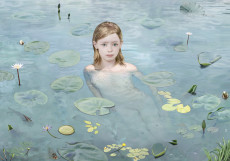 Why do you usually use children as subjects – what does childhood represent in your images?
Why do you usually use children as subjects – what does childhood represent in your images?
I have done a number of series with kids in them, but also many other series without. The child is neutral; it is closer to an animal than adults in its behavior and reactions. It’s more primitive, less formed. I think that is interesting. And, because of that, I can use them more easily as a symbol without the interference of a strong identity.
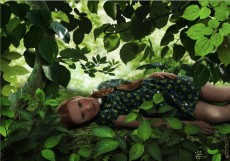 What does nature represent in your works?
What does nature represent in your works?
I use nature to effect an undefined background/location, so you could not know where the child is or what she was doing there. The background is therefore timeless and that was what I needed in order to draw all attention to the subject and its innocence. In those first portraits that I did of kids, I wanted to say something about beauty and innocence, as symbols.
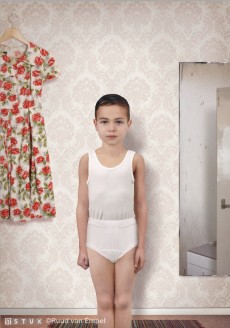 And, how exactly do you portray innocence in your photos?
And, how exactly do you portray innocence in your photos?
For example, I was a normal, standard child, I think, not much different from all the other kids. I was innocent and there was nothing special about it. Only later on, when you have grown up, does childhood seem all so magical and unbelievable; you can hardly believe that you yourself were once a little child.
And what, if anything besides aesthetics, is the significance of skin color in your work? Are you political in your work –many artists maintain a separation these days.
Black skin is a charged subject in the Western World, I discovered. I actually did not realize the extent to which this is true when I first started my World Series. I had no political intentions. I used black children as symbols for innocence because I thought there was no difference between a black and a white kid. But this was in fact never done before in Western Art history, I was told, so my choice was in fact special, while I just thought it was obvious. I just 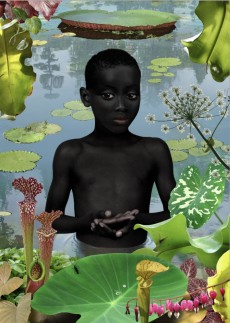 wanted to portray kids in a respectful way; make them look beautiful because that is what they are. I am not a very political artist, politics is not my subject, and in this case it was unintended. I can understand depoliticizing your art as an artist today. It was popular in the ‘fifties, ‘sixties and ‘seventies – politics in art – but in the nineteen-eighties the world started to change; to have a strong political meaning in your art does not have the same effect now as it used to. The world is changing rapidly and so art is also changing.
wanted to portray kids in a respectful way; make them look beautiful because that is what they are. I am not a very political artist, politics is not my subject, and in this case it was unintended. I can understand depoliticizing your art as an artist today. It was popular in the ‘fifties, ‘sixties and ‘seventies – politics in art – but in the nineteen-eighties the world started to change; to have a strong political meaning in your art does not have the same effect now as it used to. The world is changing rapidly and so art is also changing.
It’s interesting that, despite even the artist’s intentions, politics will still seep in and color the art. Perhaps the two often can’t be separated after all. What of the use of your photos in classrooms in Kigali, Rwanda? What is your reaction to this?
My work was a subject of study in a photo class there. I was very proud to see this on the Internet. I wish I could have been there to give a workshop.
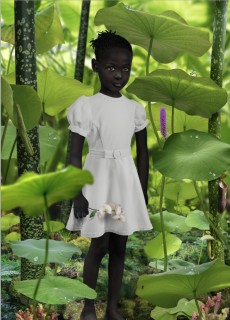 Absolutely. Instead, can you break down and describe for us your extremely detailed collage process?
Absolutely. Instead, can you break down and describe for us your extremely detailed collage process?
First comes an idea – then I start to take the photos. After loading them into my database I start working with them, taking pieces from each photo and assembling people, nature, just about everything, and building it in every detail, so that faces – the whole body – are created from many photos. The same goes for trees and so on. It is an artistic process in which I must make many decisions, and it takes weeks for a work to be completed. It is complicated and fails now and then, but it seems to be the perfect way for me to make an image. I love photography, but just a photo is not enough for me.
To this extent is there deeper significance to your human-hybrids, or are you just taking photo shop to its limits? For example, are themes like nature vs. technology and issues such as genetic engineering particularly of any deeper interest to you as an artist?
I like to discover new possibilities in photo shop but its just a tool, it has also limitations. The subjects are the main goal for me; transmitting these into a fresh, new sort of image – that’s the value of photo shop. Subjects such as this planet and how life manifests itself there, or ephemerality – I am 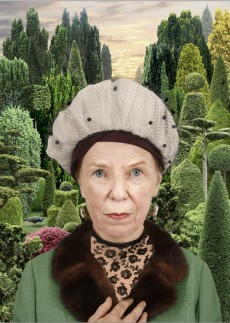 working on this subject right now. I have done a few works – Nature 1 and 2 – that show a doll’s head rotting in the shrubbery, and recently, I made Still Life, depicting fungi. It shows a dinner table on which everything is rotting. The fungi are growing on all the food. Some of those works are on display at the moment at Jackson Fine Art, in Atlanta
working on this subject right now. I have done a few works – Nature 1 and 2 – that show a doll’s head rotting in the shrubbery, and recently, I made Still Life, depicting fungi. It shows a dinner table on which everything is rotting. The fungi are growing on all the food. Some of those works are on display at the moment at Jackson Fine Art, in Atlanta
So you’ve veered away from children as subjects.
I am not working with kids at the moment.
What other artists out there are doing interesting things in your opinion? Who do you like currently?
Amongst the many I like, there’s John Currin, Kerry James Marshall, Paolo Ventura and Lucian Freud at the moment. For example, I like Lucian Freud for his powerful nudes that are not embellished and that show the body the way it is – in very original poses – yet they are still elegant.
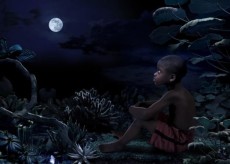 Are there any other new shows coming up? Any books or other related projects that you’d like to speak of?
Are there any other new shows coming up? Any books or other related projects that you’d like to speak of?
As for upcoming shows, there’s a solo show with new works at Stux Gallery http://www.stuxgallery.com/upcomingExhibitions, NY, opening October 30th, 2014. And at Gallery Wagner+Partner in Berlin, opening May 1st, 2015. Also, I have solo shows at Phnom Phen Photo in Cambodia, January 30th, 2015 and at the Foto Art Festival in Bielsko Biala, Poland, in October 2015.
-Larissa Zaharuk
 To See more of Rudd Van Empel’ s work,: http://www.ruudvanempel.nl/site/
To See more of Rudd Van Empel’ s work,: http://www.ruudvanempel.nl/site/
All Images courtesy of Stux Gallery & Ruud van Empel ©Ruud van Empel

